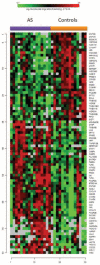Whole-blood gene expression profiling in ankylosing spondylitis shows upregulation of toll-like receptor 4 and 5
- PMID: 20952467
- PMCID: PMC3014385
- DOI: 10.3899/jrheum.100469
Whole-blood gene expression profiling in ankylosing spondylitis shows upregulation of toll-like receptor 4 and 5
Abstract
Objective: to identify differentially expressed genes in peripheral blood cells (PBC) of patients with ankylosing spondylitis (AS) relative to healthy controls and controls with systemic inflammation.
Methods: we investigated PBC samples of 16 patients with AS and 14 matched controls, in addition to systemic lupus erythematosus (SLE) and systemic sclerosis (SSc) samples utilizing Illumina Human Ref-8 BeadChips. Candidate genes were confirmed using quantitative PCR. Subsequently, these genes were also validated in a separate sample of 27 patients with AS [before and after anti-tumor necrosis factor (anti-TNF) treatment] and 27 matched controls.
Results: we identified 83 differentially expressed transcripts between AS patients and controls. This gene list was filtered through the lists of differentially expressed transcripts in SLE and SSc, which resulted in identification of 52 uniquely dysregulated transcripts in AS. Many of the differentially expressed genes belonged to Toll-like receptor (TLR) and related pathways. TLR4 and TLR5 were the only dysregulated TLR subtypes among AS patients. We confirmed the overexpression of TLR4 and TLR5 in AS patients in comparison to controls (p = 0.012 and p = 0.006, respectively) and SLE (p = 0.002, p = 0.008) using quantitative PCR in the same sample. Similarly, TLR4 (p = 0.007) and TLR5 (p = 0.012) were significantly upregulated among the AS patients before anti-TNF treatment in the confirmatory sample. TLR4 (p = 0.002) and TLR5 (p = 0.025) decreased significantly after anti-TNF treatment.
Conclusion: PBC gene expression profiling in AS shows an upregulation of TLR4 and TLR5. This supports the importance of TLR subtypes in the pathogenesis of AS that are responsible for the immune response to Gram-negative bacteria.
Figures



References
-
- Brown MA. Genetics and the pathogenesis of ankylosing spondylitis. Curr Opin Rheumatol. 2009;21:318–23. - PubMed
-
- Braun J, Sieper J. Ankylosing spondylitis. Lancet. 2007;369:1379–90. - PubMed
-
- Gu J, Rihl M, Marker-Hermann E, Baeten D, Kuipers JG, Song YW, et al. Clues to pathogenesis of spondyloarthropathy derived from synovial fluid mononuclear cell gene expression profiles. J Rheumatol. 2002;29:2159–64. - PubMed
-
- Rihl M, Kellner H, Kellner W, Barthel C, Yu DT, Tak PP, et al. Identification of interleukin-7 as a candidate disease mediator in spondylarthritis. Arthritis Rheum. 2008;58:3430–5. - PubMed
Publication types
MeSH terms
Substances
Grants and funding
LinkOut - more resources
Full Text Sources
Medical
Research Materials
